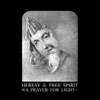 2011 is turning into the year of van Wissem. In addition to The Joy that Never Ends on Important Records, Jozef has released three collaborative records on his own Incunabulum imprint this year, including one unlikely pairing with Smegma. A Prayer for Light, recorded on Easter in 2010, features Robbie Lee, who has performed with Howling Hex and Baby Dee, as well as True Primes multi-instrumentalist Che Chen. Together they riff on a semi-ritualistic and improvised sound that makes van Wissem's music more approachable and fulfills his desire to see the lute liberated from its dusty Renaissance confines.
2011 is turning into the year of van Wissem. In addition to The Joy that Never Ends on Important Records, Jozef has released three collaborative records on his own Incunabulum imprint this year, including one unlikely pairing with Smegma. A Prayer for Light, recorded on Easter in 2010, features Robbie Lee, who has performed with Howling Hex and Baby Dee, as well as True Primes multi-instrumentalist Che Chen. Together they riff on a semi-ritualistic and improvised sound that makes van Wissem's music more approachable and fulfills his desire to see the lute liberated from its dusty Renaissance confines.
In the past three years, certain of Jozef van Wissem's compositional habits and traits have been singled out for commentary repeatedly. By now everyone knows that Jozef likes to write melodic palindromes, that he enjoys repeating these melodies over very long durations, and that he has employed some of Burrough's cut-up strategies in song forms that would otherwise sound antiquated to most ears. In addition, his lute frequently receives more attention than he does, and it's easy to understand why. Watching him play live, the lute becomes omnipresent; it's a beautiful instrument that comes with a long history, a unique sound, and peculiar mystique.
All of this makes it easy to forget just how forward-thinking van Wissem is. Whiffs of Cage-ian philosophy and minimalist sensibilities turn up in his interviews as much as they do in his music. His live sets have consisted of lute and field recordings from airports, he has played alongside Gary Lucas, whose bottle-necked resonator guitar wasn't invented until the 20th century, and he has even collaborated with legendary noise-maker, Maurizio Bianchi. Beyond the techniques and religious imagery that make up his musical persona is a performer that also wants to make the lute "sexy." On A Prayer for Light he comes close to doing that.
There is a menagerie of instruments spread across its eight brief songs, including tape machines, a portative organ, bass clarinet, banjo, bells, and a bowed rawap. There are times when they command the music more than van Wissem's lute does, and on both the first and last song, the lute isn't featured at all. When it does show up, it doesn't hog the stage. Sometimes Jozef uses it to add color to the drafty textures Chen and Lee form from their arsenal, but more frequently he turns the lute into an anchor; it provides the rhythm and forward motion, the other instruments help paint the scenery. That scenery is mostly stone walls, candle-lit rooms, dark corridors, and robed figures, so van Wissem's attitude and ascetic survive the changes in technique and emphasis.
The difference is a psychedelic edge and loose tension that arises from the way the trio interacts. There are even some rock 'n' roll moments, where booming drums and dramatic crescendos suddenly boil up from the soup of criss-crossing strings and tape. Jozef's favorite up-and-down melodies break down in places, too, causing the patterns he weaves to dissolve into tone clusters and fragmented designs. This frees the lute from its stately past—and from van Wissem's typical strategies, too. Without a particular technique or strategy guiding the group along, the music blooms and is allowed to become its own thing; the sounds breathe through the musicians rather than the musicians forcing them to leap and balk in measured ways.
I enjoy many of van Wissem's records, but I prefer hearing him like this. His compositional aspirations ring as clearly as a bell even within a group framework, and the added dimensions his band mates bring to the table, whether sexy or simply more dynamic, help underscore Jozef's singular and very contemporary language.
samples:
- LP only = no samples. Sorry!
Read More

